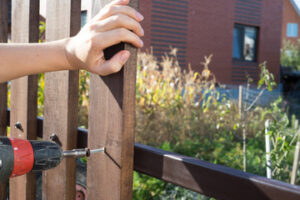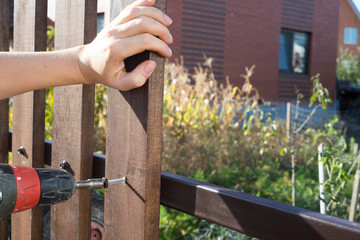Fencing Repair is an important part of keeping your fence looking good and extending its lifespan. Whether it’s a minor cosmetic issue or more extensive damage, these repairs can prevent further problems and costly replacements.
 Fencing Summerville SC has specialized tools and equipment that can be used to repair your fence quickly and efficiently. These tools will also be safer to use than regular home-store products.
Fencing Summerville SC has specialized tools and equipment that can be used to repair your fence quickly and efficiently. These tools will also be safer to use than regular home-store products.
A broken post can cause a number of issues that can range from minor to catastrophic. Ultimately, it will depend on the severity of the damage and the condition of the rest of the fence as to whether a simple repair or replacement is needed.
If the post is completely broken, it will need to be replaced. The first step in this process is to separate the broken post from the rest of the fence. This can be done by removing any nails or screws that hold one or more fence panels to the damaged post. Once this is completed, the old post can be removed and a new one can be installed in its place.
Once the new post has been installed, it must be filled in with concrete. If you’re doing this on your own, it’s recommended that you use a premixed bag of fast-setting concrete and follow the package instructions to prepare and mix the material. Once it is ready, it can be poured into the hole and tamped down tightly.
You’ll also want to check on the fence boards (or pickets) status. It may be time for a full replacement if they are splintering or showing signs of warping.
Another common issue that can occur with a wood fence is a leaning post. This problem can be caused by a variety of factors, from the wind blowing against the fence to the ground shifting around the base of the post. Depending on the severity of the lean, it may be possible to fix it by loosening the post and straightening it using a sledge hammer.
If the lean is severe, however, it may be necessary to dig out the entire post and foundation, and then replace it with a new, stronger one. This is a labor-intensive job, but it’s the only way to ensure that the post will remain in place. Ideally, it should be done as soon as the issue is noticed, as the structure of the fence will be compromised if left to the elements over time.
Leaning Posts
A fence post that’s leaning can not only look unsightly, but it can also pose a safety hazard for pets or children. Fortunately, there are some simple steps you can take to straighten the leaning post. First, clear away any debris or mud that’s accumulated at the base of the fence post. Then, start by digging around the post with a shovel to loosen the soil and help you push the post back into place.
It’s important to note that if your fence is on a property line, you may want to get permission from your neighbor before entering their yard to repair the leaning fence post. It’s possible that they may have contributed to the problem in some way, so be sure to check with them.
Once you’ve got the soil dug out, you can try to get the fence post to stand upright by bracing it with 2 x 4s. Nail the braces onto the posts at a 45-degree angle, extending from one side of the fence to the other. This should take the weight off of the leaning post, helping to straighten it.
If the fence post is still leaning, then you’ll need to use a more heavy-duty method to fix it. One option is to dig up the post and replace it with a new one. The other option is to use a post jack. This is a tool designed specifically for this purpose, and you can rent them at most hardware stores. It consists of a metal frame that fits around the fence post, and a hydraulic system that lifts the fence post back into place.
If you’re using the post jack method, it’s a good idea to spread out a tarp nearby. This will prevent the displaced dirt from spreading around your garden and make cleanup much easier. Once the fence post is in place, use a drill to put in a set of backing plates that support the hardware used for mounting. This will ensure the post is strong and secure, and it can’t be easily knocked off-balance in the future.
Loose Rails
Loose rails are a common problem for homeowners with metal fencing. They may be caused by loose screws or other problems, but can also occur if the fence was constructed poorly. You can repair loose rails with JB weld or another similar metal epoxy. Before beginning the repair, be sure to clean the parts of any loose rust or paint and follow the manufacturer’s instructions for mixing and applying the product.
If your fence is installed on an uneven surface, you can level it by using a level or other measuring tool. It is important to level the fence before securing it permanently in place, as this will prevent your fence from becoming uneven over time and make it more likely to fall down or lean.
Drainage issues can be caused by improperly installed fences, which block storm flows and cause water to pond on your property or in neighboring yards. This can damage your fence, attract mosquitoes and hasten lawn erosion. It’s important to install a fence correctly, and to keep up with any drainage improvements that need to be made.
Damaged Panels
Solid fence panels are a popular choice for residential properties and are fairly durable, but a strong storm or snowfall can still cause them to sag or collapse. Luckily, repairing and replacing panels is relatively easy for DIYers.
The first step is to clean the damaged area. Remove any debris and sand down rough spots if needed. Then, apply vinyl patching compound over the damaged areas, following your kit’s instructions. Once the patching compound is dry, sand down the area again, if necessary. Then paint the repaired panel if you want it to match the existing color.
If a wooden panel is severely damaged, it may be necessary to replace it entirely. This is especially true if the damage involves a hole or a crack in the boarding, which will need to be replaced. The good news is that repairing holes and cracks in the boarding of most types of fence is very straightforward, and using a wood preservative should prevent further deterioration.
Another common problem with a fence is rot or insect infestation. If you discover that more than 30% of a post or panel is rotten, it’s likely best to remove the offending piece and replace it. A full replacement is also a good option if the post is leaning.
For wood fences, a simple way to repair a damaged panel is to screw blocks of wood on either side of the damaged panel and just below the bottom rail. Then lift the damaged panel onto the blocks and remove it from the ground. Once the block is in place, set a new panel on it and nail it into place.
For fences made from other materials, such as a vinyl fence, it’s important to keep your property clear of any hazards that could cause damage. Trim trees and shrubs and keep grass clippings away from the fence, if possible. This will help keep debris from blowing into or hitting your fence, and it will reduce the risk of pests or insects making their homes in your fence. In addition, you should regularly inspect your fence and remove any dead or loose branches or limbs.
